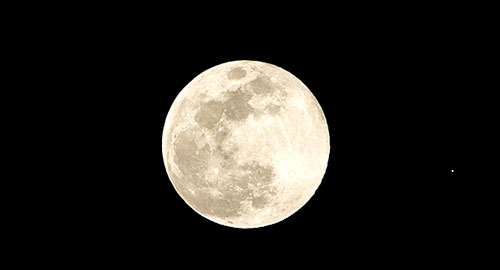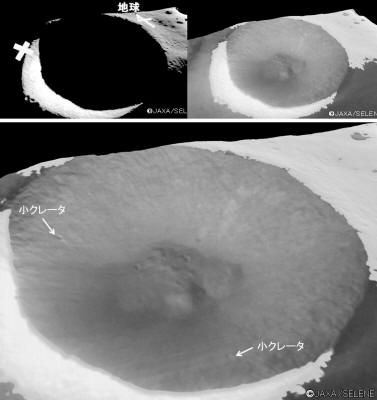|

June 23, 2012
from
TheBunsenBurner Website

Officials at NASA say that a crater on the moon hold vast quantities
of water in the form of ice, a discovery that could pave the way for
future mission to the Earth satellite.
New research shows there may be frozen water inside a massive
crater, called the
Shackleton crater, say NASA scientists.
Researchers from NASA, MIT, and Brown University say they studied
the crater with the help of a laser device, and they note that
recorded measurements indicate the presence of ice.
The team of astronomers say the laser
lit up the area and allowed them to measure the natural reflectivity
inside the crater.
"While the distribution of
brightness was not exactly what we had expected, practically
every measurement related to ice and other volatile compounds on
the moon is surprising, given the cosmically cold temperatures
inside its polar craters," said the scientists.
Using NASA's
Lunar Reconnaissance
Orbiter, the team of astronomers essentially illuminated the
crater's interior with infrared laser light, measuring how
reflective it was.
In a statement released Thursday, the
team noted that the latest data shows that upwards of 20 percent of
the crater could be covered in ice.
That said, the measured reflectance
could be the result of something else entirely, including mineral
deposits located on the floor of the crater.
"The reflectance could be indicative
of something else in addition to or other than water ice," said
study lead author Maria Zuber, a geophysicist at the
Massachusetts Institute of Technology.
For instance, the crater floor might be
reflective because it could have had relatively little exposure to
solar and cosmic radiation that would have darkened it.
Ms. Zuber noted that the measurements only look at a micron-thick
portion of Shackleton Crater's uppermost layer, noting that water
may be present at greater depths.
"A bigger question is how much water
might be buried at depth," said Ms. Zuber, adding that NASA's
GRAIL mission will investigate that possibility.
While the crater could hold ice, it
remains unclear whether ice actually exists at the bottom of the
crater.
Researchers say the measurements showed
this crater's floor is much brighter than the floor of other nearby
craters, suggesting there may be ice in it, but they added that they
can't be sure.
Scientists estimate there could be as much as 100 gallons of ice
inside the two-mile deep crater.
Shackleton crater is very large at 2 miles deep and more than 12
miles wide.

image by JAXA/SELENE (Kaguya). The upper left image
shows the normal view of Shackleton; arrows on the
large image mark impact craters on the crater rim.
Last March at the Lunar and Planetary Science
Conference, Japanese scientists very briefly flashed
on the screen an image from their Kaguya spacecraft
of the interior of Shackleton crater. This was
remarkable because the rim of Shackleton is at the
lunar south pole and the crater floor is in
perpetual darkness.
But Kaguya's
Terrain Camera is so sensitive that it could image
Shackleton's interior just from the few photons that
bounced around the interior from the narrow portion
of the rim top that illuminated. Now, in Science
magazine (Lack
of Exposed Ice Inside Lunar South Pole Shackleton
Crater) the photos have been released and
they are absolutely remarkable simply because they
clearly show the crater interior. Shackleton has
smooth walls, a small flat floor with one big
off-center lump and a few small ones.
One
characteristic of the floor is that it is not bright
as it would be if there were water ice on its
surface. There still may be ice under a thin veneer
of lunar soil, but it is disappointing that the
water is not there to be scooped off the surface.
Origin
Astronomers have studied the crater in recent years,
searching for ice deposits in the interior of the crater, which is
permanently dark.
While scientists have long posited that ice may
exist on the moon, previous orbital and Earth-based observations of
lunar craters have yielded conflicting interpretations over whether
ice is actually there.
The data comes just months after NASA celebrated the 2012 New Year
earlier this year by completing a space administration first,
announcing two probes in lunar orbit. For NASA, the announcement was
a fulfillment of the space agency's New Year's wish. NASA will use
GRAIL-A and GRAIL-B to study Earth's closest neighbor, the moon.
According to the space administration, the GRAIL mission will be,
"the first time any space agency has
attempted the complex set of maneuvers required to place two
robotic spacecraft into the same precise orbit around a
planetary body other than Earth so they can fly in formation."
The probes will spend about two months
reshaping and merging their orbits until one spacecraft is following
the other in the same low-altitude, near-circular, near-polar orbit,
and they begin formation-flying.
The next 82 days will constitute the
science phase, during which the spacecraft will map the Moon's
gravitational field.
|



